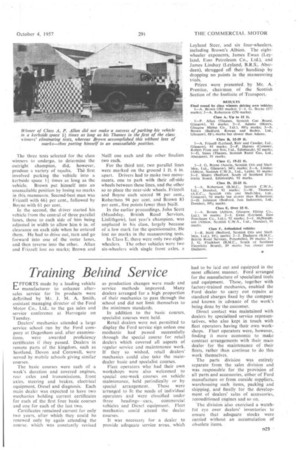Training Behind Service
Page 65

If you've noticed an error in this article please click here to report it so we can fix it.
FFORTS made by a leading vehicle manufacturer to enhance after. sales service for its products were deYeribed by Mr. J. M. A. Smith, assistant managing director of the Ford Motor Co., Ltd.. to the gas sales and service conference at Harrogate on Tuesday.
Dealers' mechanics attended a large service school run by the Ford company at Dagenham and, after examinations, were awarded proficiency certificates if they passed. Dealers in remote parts of the kingdom, such as Scotland, Devon and Cornwall, were served by mobile schools giving similar courses.
The basic courses were each of a week's duration and covered engines, rear axles and transmissions, front axles, steering and brakes, electrical equipment. Diesel and diagnosis. Each main dealer was expected to have two mechanics holding current certificates for each of the first four basic courses and one for each of the last two.
Certificates remained current for only two years, after which they could be renewed only by again attending the course, which was constantly revised as production changes were made and service methods improved. Many dealers arranged for a high proportion of their mechanics to pass through the school and did not limit themselves to the minimum standards.
In addition to the basic courses, specialist courses were held.
Retail dealers were not permitted to display the Ford service sign unless one mechanic had passed successfully through the special course for retail dealers which covered all aspects of regular service and maintenance work. If they so wished, retail dealers' mechanics could also take the maindealer basic and specialist courses.
Fleet operators whohad their own workshops were also welcomed to special one-week courses on vehicle maintenance, held periodically or by special arrangement. These were 'arranged to fit the needs of individual operators and were classified under three headings—cars, commercial vehicles and Diesel equipment. Fleet mechanics could attend the dealer courses.
It was necessary for a dealer to provide adequate service areas, which had to be laid out and equipped in the most efficient manner. Ford arranged for the manufacture of specialized tools and equipment. These, together with factory-trained mechanics, enabled the Ford dealer to carry out repairs at standard charges fixed by the company and known in advance of the work's being done by the customer.
Direct contact was maintained with dealers by specialized service representatives, who also kept in touch with fleet operators having their own workshops. Fleet operators were, however, finding it more economic to make contract arrangements with their main dealer for the maintenance of their fleets, rather than continue to do this work themselves.
The parts division was entirely separate from the sales division and was responsible for the provision of all parts and accessories, either of Ford manufacture or from outside suppliers, warehousing such items, packing and shipping, and finally for the development of dealers' sales of accessories, reconditioned engines and so on.
The division also exercised a watchful eye over dealers' inventories to ensure that adequate stocks were carried without an accumulation of obsolete items.




















































































































